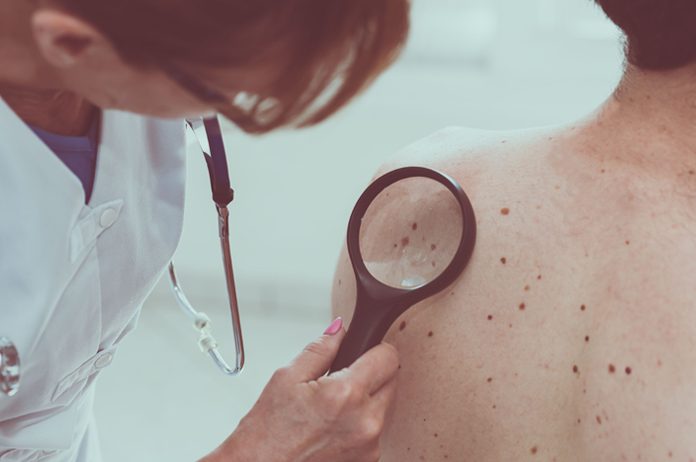Skin cancer affects the cells of our skin. It is an unrestrained growth of cancer-infected cells in the layers of our skin. If not treated too late, the cancer cells may spread to other tissues and even affect our organs.
Researchers have shown that this is the most common type of cancer, and in the United States, it has affected at least one out of five Americans. If you wonder what skin cancer looks like, you must read on to know all about it.
Skin cancer mainly occurs due to over-exposure to the sun. The sun radiates ultraviolet rays, which are detrimental to our skin as they can damage our DNA.
People with darker complexions are less prone to skin cancer as the dark skin pigment gives protection. The common causes of skin cancer include:
- Prolonged exposure to the sunrays
- People who have been earlier diagnosed with skin cancer
- Excess radiotherapy treatment or organ transplant
- Lowered immunity
- Too much exposure to chemicals
- Genetic Issues
Skin Layers and Function of Our Skin
Our skin acts as protection against dangerous contaminants. Our skin consists of mainly two layers. One is the inner thicker layer called the dermis, and the other is the thinner exterior layer called the epidermis. This layer is constantly is in touch with our surroundings.
This epidermis further includes three types of cells called the squamous cells, basal cells and melanocytes cells. The first is present in the outermost layer of skin, which is continuously shedding cells and renewing.
The basal layer is present in the deeper skin basal layer, which contains basal cells. The third is melanocytes which make melanin or skin pigmentation that determines our skin tone and colour.
Melanocyte cells produce more melanin when exposed to the sun for longer, which eventually causes a darker skin tone or tan. This actually acts as a defence mechanism and lets you know you should avoid or rather stop yourself from sun exposure completely.
Skin cancer spots appear as indications of the initial signs when one must undergo treatment immediately. The epidermis sheds skin cells constantly and getting replaced with new cells, but skin cancer occurs in some cases when the skin cell replacement takes place in a rapid multiplying process. Otherwise, our skin can sustain cuts, damages, infections, etc.
Common Four Skin Cancer Types
As the skin cells start to grow abnormally, a mass forms called the skin tumour. Generally, skin cancer is based on the several cell types of different skin layers.
- Actinic Keratoses – It is generally a precancerous growth and is also commonly called Solar Keratoses as they generally occur due to exposure to the harmful UV rays of the sun. People with fair skin are the most common patients of this kind. It shows up as flaky and dry red or pink patches on the skin. If not treated on time it can lead to squamous cell carcinoma.
- Basal Cell Carcinoma – This is the most usual type of skin cancer and commonly affects head, neck, and arms. This cancer type is slow-growing and appears as raised bumps with a wax-like or pearl-like texture. It can also be semi-transparent with blood vessels. If left uncared and untreated it can damage the surrounding tissues, nerves, and bones.
- Squamous Cell Carcinoma –This affects the cells in the outermost layer of the epidermis. It looks scaly, rough and red, and generally caused due to harmful radiations of UV rays. It grows deep in the skin which can be very injurious. Immediate treatment is required when detected.
- Melanoma – This is the most dangerous of all and can be detected by its ABCDE signs i.e., asymmetrical patches, border distortion, color in darker shades like brown and black, diameter more than six millimeters and evolution in shape and size. It happens in the melanocytes that result in our skin pigment.
Less Frequent Skin Cancer Signs
The four aforementioned skin cancer signs are most common. However, there are other kinds too that one is aware of:
- Kaposi Sarcoma is infrequent form that evolves in the blood vessels of the skin and causes purple or red spots or patches. It generally happens to people with poor immune system conditions.
- Merkel Cell Carcinoma causes firm and glossy lumps on skin. In some cases, it can grow under the layer of skin and even around follicles of hair. Merkel cell carcinoma is most often found on the neck, torso, and head.
- Sebaceous Gland Carcinoma is an unusual aggressive skin cancer forms due to excess oil present in skin. This forms hard nodules with no pain almost and it occurs on the eyelids most commonly.
The main reason for skin cancer is when you are directly subjected to the unhealthy UV rays of the sun. Skin cancer can outbreak in any part of the body, but the most common ones are on the face, neck, chest, hands, and arms.
But this does not mean that it can’t happen to people who are less exposed to the sun or have darker skin complexion. It can affect your scalp, ears, lips, neck, fingernail tip, torso, genitals, and feet.
Initially, the skin cancer signs may seem insignificant. Still, you should always be careful and take necessary measurements if you suddenly see a mole, or spot, or patches on the skin. Skin cancers generally do not hurt, especially at the beginning level and can be seen rather than felt.
Develop the new of checking for new outbreaks of moles or spots or freckles. At least once a month, self-examination is mandatory to check whether you are in your perfect health state. When going out, it is recommended to use a sunscreen lotion of the higher range of SPF, like 40 or 50.
Also, embrace accessories like sunglasses and hats for sun protection. An annual test or examination by the doctor will help detect the skin problems at the earliest so that you can take the necessary measurements to get cured perfectly.
If you ignore the skin cancer spots and signs, it will require more time and money investment in the future for surgeries and therapies. Skin cancer is prone to cause physical disfiguration and also death in many cases. It is wise to take the doctors’ advice to reduce the risk factors and help detect the earliest signs and symptoms. Leading a healthy life is very important, and when this is about your body, you should never neglect it. Always remember, the earlier, the better!






